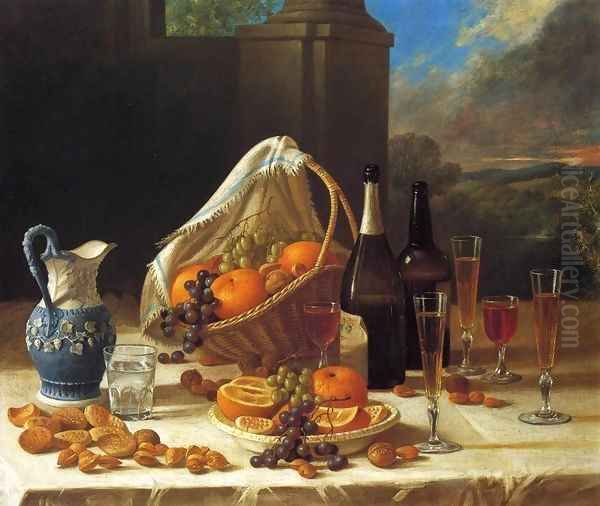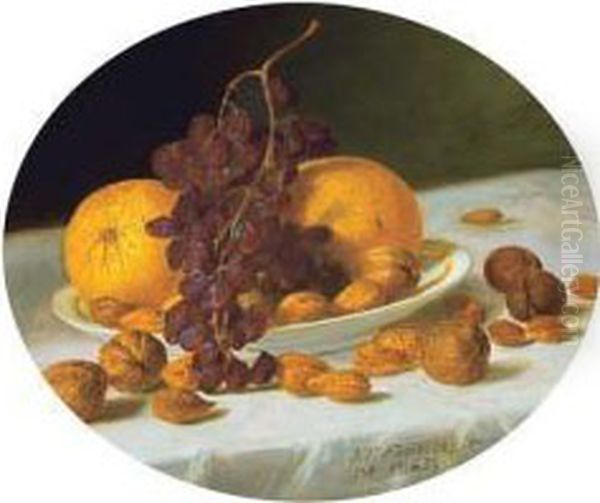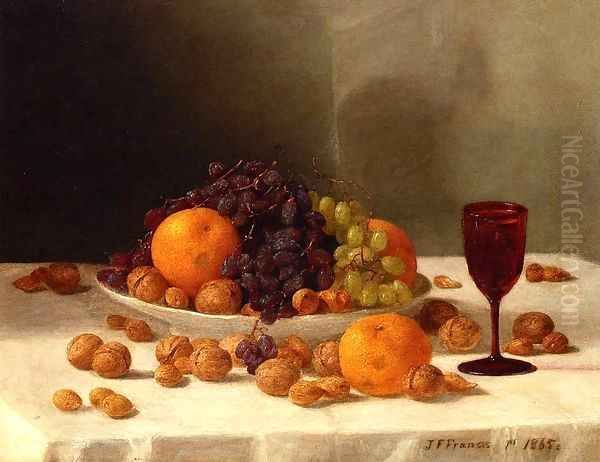John F. Francis (1808–1886) stands as a significant figure in the history of American art, particularly celebrated for his lush and inviting still-life paintings. Active during a period of burgeoning national identity and artistic development in the United States, Francis carved a niche for himself with depictions of abundant tables, laden with fruits, desserts, and the accoutrements of mid-19th-century American life. His work offers a window into the tastes and aspirations of his time, rendered with a skill that continues to appeal to audiences today.
Early Life and Artistic Formation
Born in Philadelphia, Pennsylvania, in 1808, John F. Francis emerged in a city that was then a primary cultural and artistic hub in the young United States. Philadelphia was home to the influential Peale family of artists, whose legacy in portraiture and natural history had a profound impact on the artistic landscape. While detailed records of Francis's earliest training are somewhat scarce, it is evident that he began his career, like many artists of his generation, as a portrait painter.
During the 1830s and early 1840s, Francis worked as an itinerant portraitist, traveling through Pennsylvania, Delaware, Tennessee, and Kentucky. This period would have provided him with invaluable experience in capturing likenesses and understanding human form, skills that, while not directly transferable to still life, would have honed his observational abilities and draughtsmanship. His portraits from this era, though perhaps not as renowned as his later still lifes, demonstrate a competent and direct approach.
The Transition to Still Life
Around the mid-1840s, John F. Francis began to shift his primary focus from portraiture to still-life painting. This transition was significant, as still life, while popular, was often considered a lesser genre compared to historical or portrait painting in the academic hierarchies of the time. However, in America, still life found a receptive audience, resonating with a culture that valued domesticity, abundance, and the tangible products of a fertile land.

The influence of the Philadelphia still-life tradition, particularly exemplified by Raphaelle Peale, is palpable in Francis's work. Raphaelle Peale, son of the famed Charles Willson Peale, was one of America's first professional still-life painters, known for his meticulously rendered, often spare and elegant compositions. Francis, while clearly indebted to this tradition, developed his own distinct voice, characterized by a more opulent and celebratory vision of abundance.
Hallmarks of Francis's Style
John F. Francis is best known for his "luncheon" and "dessert" pieces. These paintings typically feature tables generously spread with an array of appealing foods: glistening fruits like peaches, grapes, and strawberries; elaborate cakes, pies, and pastries; nuts, cheeses, and bottles of wine or champagne. Often, these arrangements are complemented by fine china, glassware, and silverware, suggesting a comfortable, middle-class domestic setting.
His style is characterized by a rich, warm palette and a keen attention to texture. Francis excelled at conveying the varied surfaces of his subjects – the soft bloom on a grape, the crumbly texture of a cake, the cool gleam of porcelain, or the reflective shine of a silver pitcher. While not aiming for the hyper-realism of later trompe-l'œil painters like William Michael Harnett, Francis achieved a convincing sense of materiality that made his subjects almost palpable. His compositions are often generous and somewhat informal, inviting the viewer to partake in the depicted feast.
Representative Works and Themes
Among Francis's most characteristic works are paintings titled "Luncheon Still Life," "Dessert Still Life," or variations thereof, such as "Still Life with Wine, Fruit, and Cheese" or "Strawberries and Cream." These titles directly indicate the subject matter, which often celebrated the bounty of nature and the pleasures of the table.
A typical "Luncheon Piece" might display a partially consumed meal, with bread, cheese, fruit, and perhaps a decanter of wine, suggesting an everyday yet satisfying repast. His "Dessert Pieces" are often more elaborate, showcasing cakes, tarts, and an assortment of fruits, often arranged with a sense of joyful profusion. These works reflect the Victorian era's appreciation for domestic comfort and the rituals of dining. The abundance depicted can also be seen as a reflection of America's growing prosperity and self-image as a land of plenty.
The Context of Still Life in 19th-Century America
Still-life painting enjoyed considerable popularity in 19th-century America. It appealed to a growing middle class that sought art for their homes, and its themes of domesticity, abundance, and the beauty of everyday objects resonated widely. Unlike grand historical narratives or allegorical paintings, still lifes were accessible and relatable.

The Peale family, particularly Raphaelle Peale and James Peale, had established a strong foundation for still-life painting in Philadelphia earlier in the century. Their work was characterized by careful observation and a certain classical restraint. John F. Francis built upon this foundation, infusing his work with a more robust and celebratory quality that aligned with the optimistic spirit of the mid-century. He was part of a generation of artists who helped to solidify still life as a respected genre in American art.
Contemporaries and Influences
John F. Francis operated within a vibrant artistic community. His most direct artistic predecessor in the realm of still life was Raphaelle Peale (1774-1825). Peale's precise, often spare compositions set a high standard for American still-life painting. Francis absorbed Peale's dedication to realistic depiction but moved towards more complex and abundant arrangements.
Other members of the Peale dynasty also contributed to the artistic milieu. Charles Willson Peale (1741-1827), the patriarch, was a multifaceted artist and museum founder. His brother, James Peale (1749-1831), also produced notable still lifes, often with a softer touch than Raphaelle. Rembrandt Peale (1778-1860), another of Charles's sons, was primarily a portraitist but his work contributed to Philadelphia's artistic prominence.
A contemporary often compared to Francis is Severin Roesen (c. 1815–c. 1872), a German-American painter known for his incredibly lush and elaborate fruit and flower still lifes. While both artists depicted abundance, Roesen's compositions were often more overtly decorative and overflowing, sometimes drawing on European Baroque traditions. Francis's work, by contrast, often maintained a slightly more grounded, American sensibility.
Other American still-life painters active during or around Francis's time include George Henry Hall (1825-1913), who was known for his rich depictions of fruit, particularly raspberries and peaches, and later, for his Spanish-themed subjects. Paul Lacroix (c. 1827-1869) was another contemporary who specialized in fruit pieces, often with a luminous quality.
While Francis focused on still life, the broader American art scene included prominent landscape painters of the Hudson River School, such as Thomas Cole (1801-1848) and Asher B. Durand (1796-1886), who were capturing the grandeur of the American wilderness. Genre painters like William Sidney Mount (1807-1868) and Eastman Johnson (1824-1906) were depicting scenes of everyday American life, offering a different kind of narrative focus. Later in the century, figures like Martin Johnson Heade (1819-1904) would create unique still lifes, often featuring orchids and hummingbirds, alongside his luminist landscapes. The trompe-l'œil school, with artists like William Michael Harnett (1848-1892) and John Frederick Peto (1854-1907), would take still-life realism to new extremes.
Artistic Development and Later Career

Throughout the 1850s and 1860s, John F. Francis continued to produce a significant body of still-life work. He exhibited regularly at prestigious institutions such as the Pennsylvania Academy of the Fine Arts and the National Academy of Design in New York. This indicates a degree of recognition and acceptance within the established art world of his time.
His style remained relatively consistent, though there is evidence of subtle evolution. Some later works show an even greater richness in color and complexity in composition. He continued to explore variations on his favored themes of luncheon and dessert tables, always with an eye for appealing arrangements and convincing textures. His dedication to still life, even as other artistic trends emerged, speaks to his commitment to the genre and his confidence in its expressive possibilities.
The Civil War era (1861-1865) and its aftermath brought significant changes to American society and art. While Francis continued to paint, the taste for his particular style of abundant still life may have shifted somewhat as new artistic movements, including influences from Europe like the Barbizon School, began to gain traction in America.
Legacy and Reappraisal
John F. Francis passed away in 1886. Like many artists of his generation whose work fell out of fashion with the rise of modernism, his reputation experienced a period of relative obscurity. However, in the mid-20th century, there was a renewed scholarly and public interest in 19th-century American art, leading to a reappraisal of figures like Francis.
Today, his paintings are held in numerous important museum collections across the United States, including the Metropolitan Museum of Art, the National Gallery of Art, and the Museum of Fine Arts, Boston. Art historians recognize him as one of the leading American still-life painters of the mid-19th century. His work is valued not only for its aesthetic qualities – its appealing subject matter, rich color, and skilled rendering – but also for what it reveals about American culture and values during his lifetime.
Francis's paintings offer a vision of optimism and material comfort that characterized a particular segment of American society. They celebrate the simple pleasures of life and the bounty of the natural world, themes that retain their appeal. His ability to make these everyday subjects engaging and visually delightful is a testament to his skill and artistic vision.
Conclusion: A Painter of Generous Spirit

John F. Francis occupies an important place in the narrative of American still-life painting. He successfully transitioned from portraiture to become a specialist in a genre that resonated deeply with the American public. His "luncheon" and "dessert" pieces are iconic examples of mid-19th-century still life, capturing a sense of abundance, domesticity, and the simple joys of the table.
Influenced by the Philadelphia tradition of the Peale family, particularly Raphaelle Peale, Francis developed a distinctive style characterized by warm colors, rich textures, and generous compositions. He stands alongside contemporaries like Severin Roesen in depicting the bounty of America, though with his own unique, often more grounded, sensibility. His work provides a valuable glimpse into the material culture and aesthetic preferences of his era, and his skill in rendering his subjects with such inviting realism ensures his continued appreciation. John F. Francis remains a painter whose canvases extend a warm and generous invitation to the viewer, celebrating the richness of life with enduring charm.